ABSTRACT
The advent of urbanization and its concomitant increase in urban population has catapulted the street food industry into a crucial role in meeting the food demands of urban residents. Health experts however, have continued with the argument that numerous health hazards are associated with these street vended foods. This paper explores safety and hygiene status of urban street vended foods in Ho which has traces as an urban community being the Volta Regional capital 0town in Ghana. Data was sourced from the street food vendors, customers and key personalities at the forefront of Public and Environmental Health making use of both simple random and purposive sampling techniques. Semi structured questionnaires; in depth interviews (IDI) and personal observation were employed in data collection. In all, one hundred (100) respondents participated in the study. The analysis revealed that majority of the street vended foods in Ho was only partially safe for human consumption. Poor construction and location of vending sites, inadequate sanitary facilities, poor personal hygiene, temperature abuses and sub-standard packaging were identified as the main variables responsible for the low safety and quality of the street foods. The paper recommends that the Asogli Traditional Council, Ho Municipal Assembly, the Ghana Tourism Authority and civil society organizations should help regulate the activities of street food vendors by enforcing codes of practice for the street food business. Workshops and talk shows should be considered in order to expose food vendors to basic hygiene and sanitary practices necessary for food handling and preparation to promote food hygiene, sanitation and safety.
Key words: Food vendors, safety, street food, quality.
Street food vending is a common phenomenon in Ghanaian towns and cities. By way of definition, street vended foods are ready-to eat foods and beverages sold by vendors and hawkers on the street or prepared in the home and consumed on the street without subjecting it to further preparation (FAO,1990). They are less expensive and the most accessible means of obtaining food. With the unprecedented urban growth and especially the increase in the size of the unemployed labour force, the demand for street vended foods has gained momentum. The ready-to-eat foods as they are generally called are sold by vendors and hawkers in make-shift stalls, push carts by the streets and public places like mechanic sites, markets, etc.
In Ghana, the presence of street foods and street food vendors has become one of the most fascinating aspects of social life in urban and peri-urban centres. In fact, street food trade is becoming a viable and important informal-sector industry. Besides convenience, it offers business opportunities for many entrepreneurs. The sale of street foods enhances the income of the operators and meets the food demands of urban dwellers especially the low income group. Though street food vending in Ghana is not a new phenomenon, there has been a steady increase in the number of operators in recent years. This increase could be attributed to the poor state of the Ghanaian economy. The country has been experiencing unprecedented rate of socio-economic challenges. Unemployment has continued to rise due to the declining economic situation.
Consequently, there has been increasing migration of youth to the urban centers. The migration has continued to create a high demand for ready-to-eat foods by the migrants. In the face of the harsh socio-economic situation, these foods are relatively cheap and readily available for the teeming unemployed. Though street vended foods are relatively cheap and accessible, their safety and quality have remained a serious issue of concern to health experts and international bodies (Agu, 2011). According to the World Health Organization (WHO, 1984) and Ashenafi (1995), street vended foods are prone to be contaminated by either spoilage or pathogenic micro-organisms. The Food and Agricultural Organization (FAO,1997) also maintained that street vended foods are prone to food poisoning due to improper and unhygienic handling of the foods and the unregulated nature of this sector of the economy.
In Ghana, surveys carried out by the Department of Public Health of the Ministry of Health in 2006 and 2007 gave over two hundred cases of food borne diseases and the number of deaths a little over fifty. Many of these deaths were said to be linked to the consumption of contaminated street foods. Also, the Consumer Protection Council survey on street vended foods within the National Capital Territory (Greater Accra Metropolitan Area) gave a similar scenario that presupposes that the situation could be worse in the hinterland (Agu, 2011).
Studies by Abdulsalam and Kaferstein (1993) have also confirmed that foods sold by the streets have strong epidemiological links with illness. Over the years, Ghanaians have come to appreciate local delicacies commonly hawked in our streets. Interestingly, Ghana is an agrarian country with rich varieties of foods. Unfortunately, most of the street foods vendors appear less conversant with the best practices of food preparation, presentation, packaging and preservation. But considering the above positions and the continued increase in the number of operators of street foods, one hazards urban resident are being exposed to food hazards. How are street foods handled in the course of preparation? What is the hygiene status of these foods at the time of customer intake? This paper explores safety and hygiene status of street vended foods in Ho township.
This research used a survey research design which is a procedure in qualitative research in which investigator administer a survey to a sample in order to describe the attitudes, opinions, behaviors or characteristics of the population (Cresswell, 2002) Data was sourced from the street food vendors and key personalities at the forefront of Public and Environmental Health making use of both simple random and purposive sampling techniques. Semi-structured questionnaire, in depth oral interviews (IDoI) and personal observation were employed in data collection. In all ninety seven (97) street food vendors and ten (10) customers responded simple randomly to the questionnaire and three (3) Public and Environmental Health officials were interviewed purposively. The information obtained is presented in descriptive and thematic forms.
The study sought to identify the most common street foods vended in the study area. Among them, kenkey emerged as the leading street vended food (Table 1 and Figure 1). The population of pepper soup with Akafa vendors was the least in the street food vending business. Majority (63.9%) of the food vendors were female (Figure 2 and Figure 3). This finding conforms with Adayfio-Schandorf (2007) observation of gender specialization of livelihood activities. In terms of age, the vendors were between 20 and 50 years. The majority of them (67%) were between the ages brackets of 31 to 40 years (Figure 4). Only 12.4% of the vendors were in the age bracket of 41 to 50. This result supports Yaro (2006) assertion of a poor correlation between age and engagement in manual livelihood activities. On the basis of educational training, only 13.4 % of the vendors had post-basic education (Figure 5).

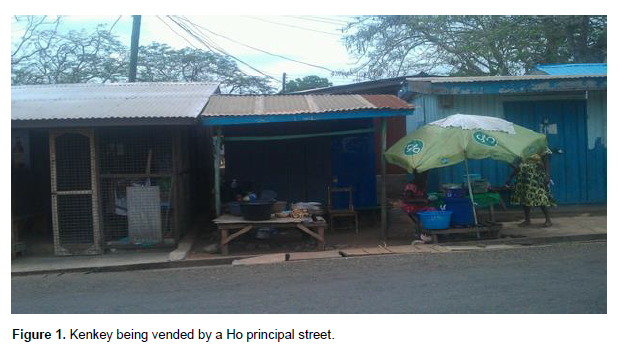
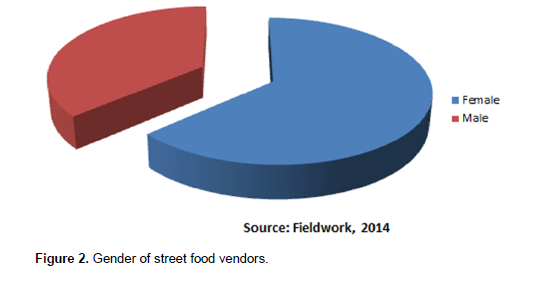
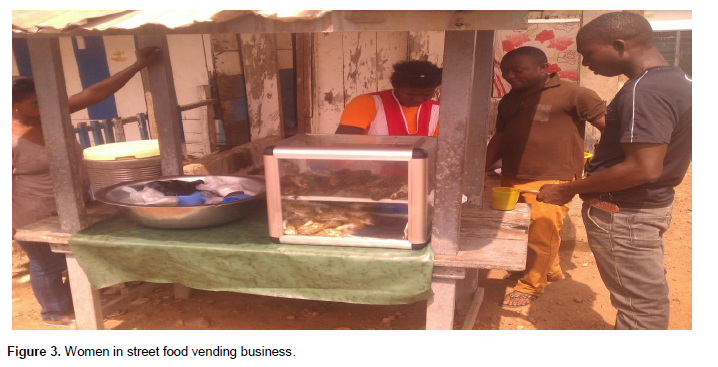
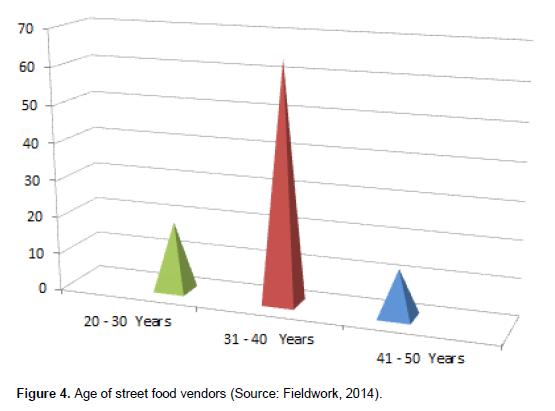
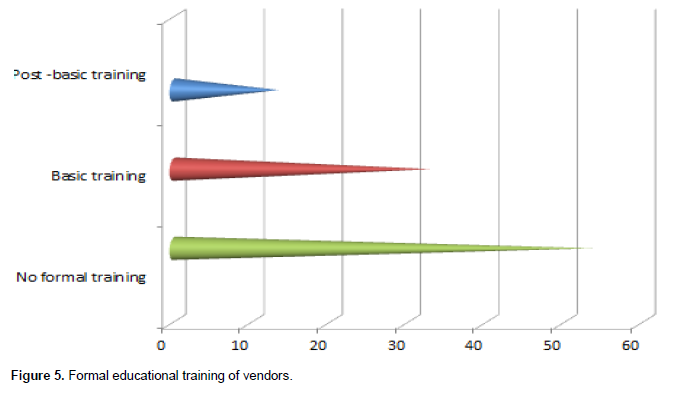
Majority of the vendors (53.6%) reported acquiring no formal education while 32.9% had basic education. This suggests a low intellectual training of Ho street food vendors including personal hygiene and social skills imparted from formal training institutions. In depth interviews with the food vendors revealed that they had no formal training in food preparation (catering) and food handling but rather got their cooking skills through their parents and later improved upon them through self-training. Gross temperature abuses were discovered (Figure 6). Meat snacks especially sausage were visibly under-done or over-cooked. This was confirmed in the interview with the Municipal environmental health officer.
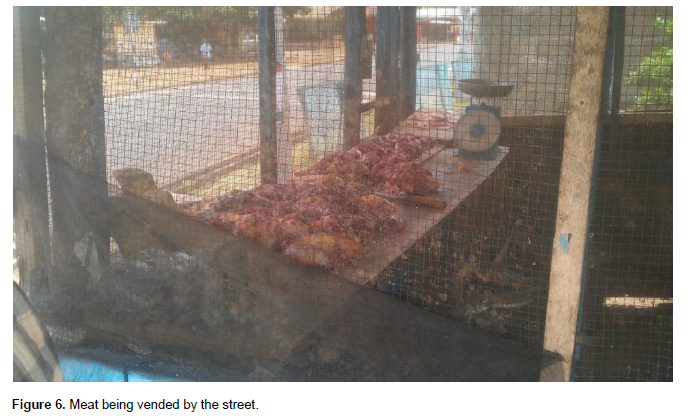
With regards to operation site, it was observed that 52.5% of the food vendors sold their foods in wooden stalls along the principal streets (Table 2 and Figure 7). It was observed that besides operations under umbrellas, all the other vendors prepare their foods at permanent sites with the help of unskilled hands. It was seen that most of the vendors (especially the relatively sedentary ones) operated in less clean environments (Figure 8). Wastes and garbage were sighted lying indiscriminately as many of them had far away garbage receptacles. The vendors prepared their foods on visibly dirty surfaces (Figure 9).
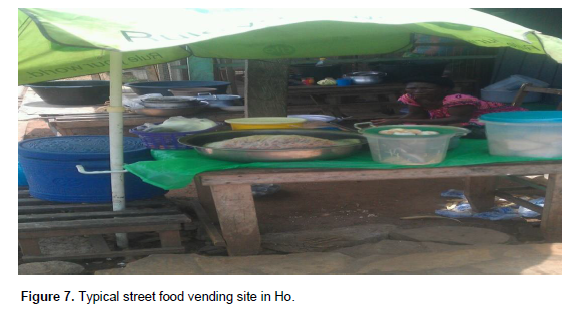
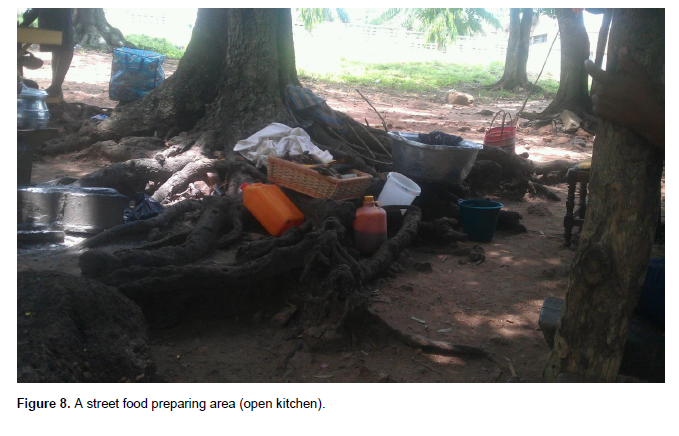
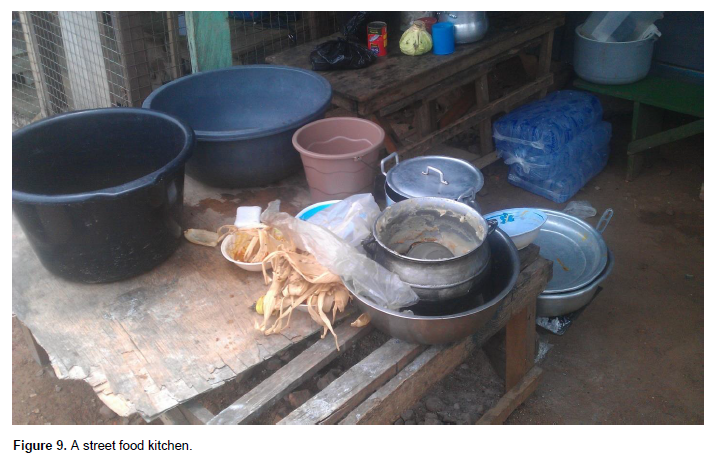
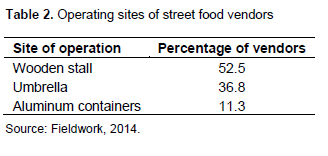
The observation showed that while cooking or serving food, only 11% of the vendors including their assistants either wore aprons or covered their hair. Most of the women vendors (65%) had fairly long nails and wore jewelries. Most of the food vendors also handled money while cooking and serving food while public toilet facilities were eight meters away on average from 70% of vendors. Most customers interviewed (70%) admit patronizing the street foods regularly though they claim full awareness of the potential safety issues associated with street foods.
The population of Ho the Volta Regional capital town of Ghana continues to increase since the establishment of the University of Health and Allied Sciences and the Evangelical Presbyterian University College some six years ago. Due to this, street food industry has been playing an important role in meeting the food demands of the inhabitants. Hundreds of Ho settlers are fed daily with a variety of relatively cheap street foods. Studies by Muleta and Ashenafi (2001) and Omemu and Aderoju (2008) concluded that street foods are sources of cheap food and nutrition for many low-income groups.
However, public health experts have continued to argue that several health hazards are associated with these street vended foods: that life threatening diseases are associated with these streets foods. The Food and Agricultural Organization (FAO, 1990) for instance, maintains that street foods are largely unsafe because the vendors are often untrained in food safety, food hygiene and sanitation and most often work in unsanitary conditions. In the context of Ho, only a handful of the vendors had formal training up to the senior high school level while the majority had no formal training. And few of the vendors had basic training in food handling and preparation. This implies that knowledge about food vending was acquired by self-teaching - trial and error. But for food safety and hygiene to be assured, the food handlers must of necessity possess the knowledge and skills to enable them handle food hygienically (Sharmila, 2011).
The case of Ho has established that due to the low level of literacy, lack of proper training and guidance on food vending, vendors prepared their foods in less hygienic and sanitary conditions. The study also observed that most of the food vending sites were poorly constructed and located thereby exposing the foods to flies, dust and vehicular emissions. In addition, refuse, garbage and waste water were observed to be recklessly thrown around. This attitude has made most of the food sites breeding places for flies and other related infections, contaminations and hazards. Studies by Muinde and Kuria (2005) have confirmed that the lacks of facilities for liquid drainage and waste water, and garbage disposal lead to garbage accumulation which provides harborage for insects and animal pests that are linked to enteric disease transmission.
The study established that access to portable and potable water is costly to Ho street food vendors. But water is an important raw material in many street vended operations. Due to cost accessibility challenges of clean potable water, most of the vendors re-used the water especially for cleaning utensils and used dishes. But studies by Angula et al. (2008) has shown that contaminated water creates a public health risk when it is used for drinking, washing of foods, used in the processing of food or used for washing equipment, utensils and hands. Instances of gross temperature abuses were also discovered. WHO (1989) maintained that inadequate heating and under cooking can contribute to food poisoning. The study also discovered risk factors relating to food packaging. For instance, it was observed that many of the foods were presented and delivered without protective packaging. For example, the meat snacks, the beans cake (agawu) were wrapped in old newspapers and cement bags. But the heaps of newspapers and cement bags usually serve as good breeding places for cockroaches and other insects that can cause serious illness. Moreover, in the houses where these newspapers and cement bags are kept, deadly chemicals or insecticides like nuvan or sniper popularly called “Gbagbladza tike” are applied to ward off the menace of the cockroaches and other insects that breed in the homes because of the papers and bags. These papers are later used to wrap the food. It was also observed that many of the vendors in the process of packaging, clean off the dust on the newspapers and cement bags by blowing air and in the process pass on a number of pathogens to the consumers. This is what Sharmila (2011) calls the introduction of hazards by cross contamination.
Similarly, “Liha” sellers collect empty bottles from different sources in which the ‘liha’ is bottled and sold to consumers. This is usually done with less regard to what the bottles were subjected to. The safety of any food is dependent on the personal hygiene of individuals. This position is strongly emphasized by Marriot (1985) as he states that personal hygiene is important because human beings are the main sources of food contamination (Akinyele 1987; Sharmila, 2011).
In the study context, it was observed that toilet facilities were not available in most of the vending sites visited. Vendors passed out body wastes in near-by hidden places and returned to business without washing their hands wear long nails and this is a sure way of contaminating and introducing microbes on food. It is the position of this study that the chemicals women apply on their hair and fingernails are harmful. Besides, the long nails are sure places for the incubation and breeding of germs. Therefore, exposing these into contact with food can have severe health implications for the people.
This study examined the safety and hygienic status of street vended foods in Ho Township. The study observed that street food vendors prepare food in not so hygienic and less sanitary conditions. It was particularly noted that these street foods are generally less safe for human consumption as most of them are exposed to dust and vehicular emissions due to the poor location and construction of the vending sites. It was observed that most of the food preparation sites are breeding places for flies, rodents and other insects as they are generally littered with waste water, garbage and refuse. In addition, most of the food vendors lack basic food handling skills as most of them handle money, hardly cover their hair or use aprons while serving food. More so, the women vendors prepare food with long and painted nails.
The study recommends that the local government in Ho should activate the regulation of activities of street food vendors by strictly enforcing codes of practice for the street food business. The necessary conditions should be put in place to ensure that food vendors comply with hygienic and sanitary standards. Talk shows or training programmes should be regularly organized to expose the street food vendors to basic hygiene and sanitary practices necessary for food handling and preparation to ensure the safety and quality of street food. Again to ensure compliance to environmental sanitation laws, staff of the environmental health unit of local government authorities in all major towns in Ghana should be empowered and equipped to operate effectively and efficiently. The presence of the sanitation officers is believed would compel food vendors to clear their sites of refuse and garbage. Above all, the synergy between the Consumer Protection Council, the National Commission of Civic Education (NCCE) and other relevant bodies should be strengthened particularly in the area of training of street food vendors on appropriate food preparation methods, presentation as well as the maintenance of good personal hygiene.
The authors have none to declare.
REFERENCES
|
Abdulsalam M, Kaferstein FK (1993). "Safety of Street Foods" World Health Forum; No. 14.
|
|
|
|
Adayfio-Schandorf E (2007). Gendered Poverty, Migration and Livelihood Strategies of female Porters in Accra, Ghana. Norwegian J. Geogr. 62:171-179.
|
|
|
|
Agu I (2011). Food safety practices in Nigeria. Food control. 20(1).
|
|
|
|
Ashenafi M (1995). "Bacteriological Profile and Holding Temperature of Ready-to-serve Food Items in an open Market in Wassa, Ethiopia". Trop. Geogr. Med. 74:1-4.
|
|
|
|
Cresswell J (2002) Educational Research: Planning, Conducting and evaluating quantitative and qualitative Research. Upper Saddle River, NJ; Merrill Prentice Hall.
|
|
|
|
FAO (1990) "Street Foods". Report of an FAO Expert Consultation. Accessed 16/6/2011.
|
|
|
|
FAO (1997) FAO Report; Rome 1-4 Accessed on 16/5/2011.
|
|
|
|
Marriot M (1985). Principles of Food Sanitation. New York: Van Nostrand Reinhold Company.
|
|
|
|
Ministry of Health (2006). 'Status of foodborne diseases in Ghana' Report of a WHO expert consultation.
|
|
|
|
Muinde OK, Kuria E (2005). Food safety issues in urban Nigeria. J. Hunanit. Soc. Sci. 4(4).
|
|
|
|
Muleta D, Ashenafi M (2001). "Salmonella, Shigella and Growth Potential of other Food-borne Pathogens in Ethiopia Street Vended Foods". East Afr. Med. J. 78(11).
crossref
|
|
|
|
Omemu AM, Aderoju ST (2008). "Food Safety: Knowledge and Practices of Street Food Vendors in Abeokuta". Food Control. 19(4).
crossref
|
|
|
|
Sharmila (2011) Exploring Street food hygiene in Senegal. FAO Technical Report series.
|
|
|
|
WHO (1984). The Role of Food Safety in Health and Development: Report of a Joint FAO/WHO Expert.
|
|
|
|
WHO (1989) Health surveillance and management procedures for food handling personnel. WHO technical report series, 785. WHO, Geneva, 52 p.
|
|
|
|
Yaro JA (2006). Is deagrarianisation real? A study of livelihood activities in rural Northern Ghana. J. Mod. Afr. Stud. 44(01):125-150.
crossref
|